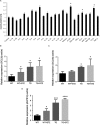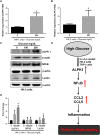ALPK1 regulates streptozotocin-induced nephropathy through CCL2 and CCL5 expressions
- PMID: 31557402
- PMCID: PMC6815771
- DOI: 10.1111/jcmm.14643
ALPK1 regulates streptozotocin-induced nephropathy through CCL2 and CCL5 expressions
Abstract
ALPK1 is associated with chronic kidney disease, gout and type 2 diabetes mellitus. Raised renal ALPK1 level in patients with diabetes was reported. Accelerated fibrotic nephropathies were observed in hyperglycaemic mice with up-regulated ALPK1. The aim of this study was to identify the mediators contributing to ALPK1 effect involving in nephropathies induction. The haematoxylin and eosin staining, Masson's trichrome and immunohistochemical analysis of ALPK1, NFkB, CCL2 and CCL5 were performed in the mice kidney. Cytokine antibody array analysis was performed in streptozotocin-treated wild-type mice (WT-STZ) and streptozotocin-treated ALPK1 transgenic mice (TG-STZ). The ALPK1 levels were measured in mice kidney and in cultured cells. We found that the higher levels of renal CCL2/MCP-1, CCL5/Rantes and G-CSF expression in TG-STZ compared with the WT-STZ. Glucose increased ALPK1 expressions in monocytic THP1 and human kidney-2 cells. The protein expression of ALPK1, NFkB and lectin was up-regulated in glucose-treated HK-2 cells. Knockdown of ALPK1 reduced CCL2 and CCL5 mRNA levels, whereas overexpressed ALPK1 increased CCL2 and CCL5 in cultured kidney cells. Taken together, these results show that high glucose increases ALPK1 and chemokine levels in the kidney. Elevated ALPK1 expression enhances renal CCL2 and CCL5 expressions in vivo and in vitro. ALPK1 is a mediator for CCL2 and CCL5 chemokine up-regulation involving in diabetic nephropathies induction.
Keywords: ALPK1; CCL2; CCL5; chemokine; diabetic nephropathy.
© 2019 The Authors. Journal of Cellular and Molecular Medicine published by Foundation for Cellular and Molecular Medicine and John Wiley & Sons Ltd.
Conflict of interest statement
The authors declare that they have no conflict of interest exists.
Figures







References
-
- Yamada Y, Nishida T, Ichihara S, et al. Identification of chromosome 3q28 and ALPK1 as susceptibility loci for chronic kidney disease in Japanese individuals by a genome‐wide association study. J Med Genet. 2013;50(6):410‐418. - PubMed
-
- Kuo T‐M, Yeh K‐T, Hsu H‐T, et al. ALPK1 affects testosterone mediated regulation of proinflammatory cytokines production. J Steroid Biochem Mol Biol. 2015;154:150‐158. - PubMed
Publication types
MeSH terms
Substances
LinkOut - more resources
Full Text Sources
Medical
Molecular Biology Databases
Miscellaneous

